When Americans think of French desserts, we think of glossy Parisian macarons, cream-filled éclairs and towering croquembouches. But the truth is, the French rarely actually eat these fancy treats themselves. More often they sate their famed sweet tooth with comforting classics, opting for rustic recipes passed down throughout the ages.
Each region of France has its own traditional dessert, well known within its place of origin but virtually unheard of outside of the country. There’s Galette de Pérouges, a kind of sugared brioche pizza made in only one medieval town; Falculelle, a petite Corsican cheesecake baked on chestnut leaves; Tourteau Fromager, an airy cake with a jet-black crust; and Teurgoule, a rice pudding made with ingredients stolen by marauding Norman pirates. These are the desserts the French actually cook at home—the kind of dishes that stir up nostalgia and offer a sense of place.
So important are these regional specialties to the fabric of French culture that confreries, or brotherhoods, have formed specifically to preserve and promote them. Members are initiated, symbolic medieval costumes are worn, and annual baking competitions are held. You need only to step outside the main tourist centers of France to realize that some of the best desserts the country has on offer are desserts you’ve never even heard of.
Pets-de-Nonnes – Provence
For something as simple as fried dough, these bite-sized treats have a complicated, if somewhat playful, naming history. In polite company, they’re simply called Beignets Soufflés, while livelier attachés take a cue from the dessert’s airy texture and petite size and refer to them as “Nun’s Farts” instead. Older cookbooks take things one step further, calling them “Whore’s Farts”, but that tradition may have died out simply because these fritters are far too delightful to be named something so dirty. Even the Bretons to the north have been made the butt of the southern joke, so to speak, with the much larger variation of the beignets widely known as the Breton’s Fart.
By any name, the Pets-de Nonnes smell far sweeter than implied. Often made in the springtime as a final treat before Lent, the eggy batter is scented with orange blossom water, fried, then sprinkled with powdered sugar. Market vendors make them fresh throughout the day, piling them in little paper bags, steam—somewhat comically—rising from the top.
Tourteau Fromager – Poitou

Martine CC BY-NC
This positively medieval cake hails from Poitou-Charentes, which is home to two thirds of France’s goats. Unsurprisingly, goat cheese is always in high supply and enterprising local bakers have learned to incorporate it into all manner of tarts and cakes. The tourteau fromager is the most famous variety, easily recognized by its jet-black crust which is credited with sealing in moisture throughout baking. Legend has it that a 19th century housewife accidentally overheated her oven, charred her cheesecake and nearly threw it away. Fortunately for us all, she peeled off the crust to see if anything was salvageable and discovered an interior as light and spongy as angel food cake. The technique stuck and locals now even leave the burnt crust in fact, as the earthy flavors pair well with a splash of Armagnac.
Broyé du Poitou – Poitou
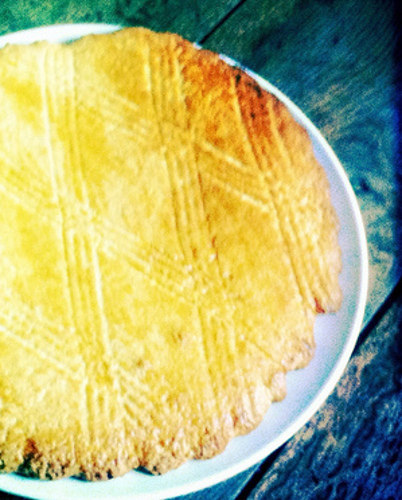
Ichut CC BY-NC-ND
The famous broyé (meaning crushed) is a single cookie big enough to feed a crowd. It was originally sent into the fields with farmers, who broke it into chunks to be shared amongst the workers. The convivial nature of the broyé caught on and it became a staple at community gatherings like mass, communion and weddings. Tradition says that the cookie is not to be cut with a knife, but rather shattered with a coup de poign, or punch, to the center. Guests can then choose a large or small piece, or even pocket a bit for later. Made with rich local butter and flecked with coarse sea salt, the broyé is slightly sweet, thoroughly crisp, and wonderfully addictive. When paired with a hot cup of coffee or even a glass of red wine, the little bits of broken cookie tend to disappear faster than the cups can be drained.
Gateau Nantais – Brittany
Located on the southern coast of Brittany, Nantes has long been a heavily trafficked port. During the 18th century, a constant flow of ships entered the city laden with exotic goods from the Caribbean colonies. Local bakers got first dibs on cane sugar, dark rum and vanilla before the goods filtered into the rest of the country. These prized ingredients were woven into many regional specialties, but the one that’s stood the test of time and remained everyone’s boozy favorite is the Gateau Nantais.
Loaded with ground almonds and a healthy dose of butter, the Gateau Nantais is a rich little number from the ge-go. But when thoroughly soaked in rum and cloaked in a thin layer of royal icing, the cake is decadent enough to make even a sailor lose his sea legs. While the gateau can be eaten immediately after baking, aficionados insist that a full day is needed for the rum to seep into all the nooks and crannies.
Teurgoule – Normandy
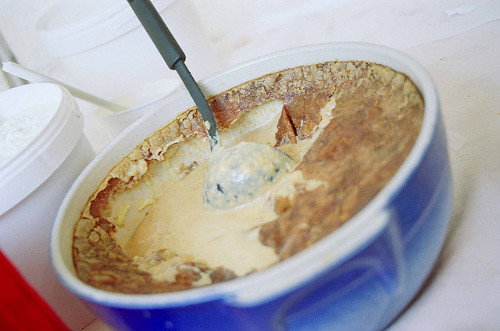
Raphaël Labbé CC BY-SA
Teurgoule translates to “twist face” in the Norman language and supposedly alludes to the astonished look on everyone’s face after first sampling the dish. It was the first time any of them had tasted cinnamon, a bold new spice brought back as booty by pirates after raiding Spanish fleets returning from the Americas.
Humble rice pudding is positively flashy when compared to its cousin teurgoule. Like rice pudding, teurgoule is made from just a handful of ingredients—rice, sugar, cinnamon, and milk—and like rice pudding teurgoule cooks into a comforting, warm porridge. But teurgoule ups the comfort factor even further with a six-hour stint in the oven, which caramelizes the top and causes the rice to completely melt until no individual grain is discernable. Once pulled from the oven in its enormous earthenware crock, it’s served family style with traditional sides of brioche and local cider.
Falculelle – Corsica
From the unconventional, rugged island of Corsica, comes an unconventional and rustic cheese. Brocciu, a strained cheese made with whey from ewe’s milk, is considered a national food in Corsica and is used in countless dishes throughout the island. It’s folded into cakes, tucked into tarts, slathered on pizza, battered and fried, or simply eaten on its own with a sprinkling of sugar. While dozens of Corsican desserts feature this iconic cheese, it’s falcullel which turns the most heads at the farmers’ markets. These individual cheesecakes are made by mixing brocciu with eggs, sugar, and the tiniest bit of flour into a batter which is then spooned onto chestnut leaves and baked at high heat. The resulting patties have a flame-licked exterior and are scented with fragrance of chestnuts.
Galette de Pérouges – Rhône-Alpes
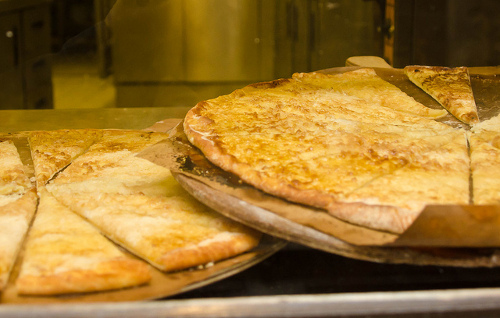
hey tiffany! CC BY-NC
Just outside Lyon is the medieval village of Pérouges, a neat package of cobbled streets and shuttered windows wrapped up within ancient town walls. While it has now been lovingly restored, the charming town was once all but abandoned and under serious threat of demolition. In 1912, a woman named Marie-Louise Thibaut settled there with her husband and established a commission to salvage the village and draw tourists. One of her main projects was the opening of the Hostellerie de Pérouges, a hotel and restaurant in a 600-year-old building. Thibaut created a menu inspired by medieval dishes, which featured an ancient recipe for a wood-fired sugar tart. The town was saved and the tart still remains one of its main draws.
Galette de Pérouges has a wide, round base like a pizza and is made of a sweet, brioche-like dough. The top is brushed with butter and sprinkled with sugar before the whole thing is slid into a wood oven with the aid of a paddle. The high heat of the flames crisps the bottom of the crust and caramelizes the sugared top. Buy a slice to go from a vendor on the street, or grab a table at the Hostellerie de Pérouges to try it with a dollop of fresh cream.
Matefaimes – Franche-Compté
More snack then dessert, these in-between-meal treats are said to literally “cut hunger”. Matefaimes originated as hearty potato pancakes, sturdy enough to be slipped into a rucksack and taken into the fields with workers during a long day of work. Over time, the pancake was made sweeter with milk and sugar, and the potatoes were eventually swapped with apples. While savory variations with cheese and potatoes can still be found, it’s the sweeter matefaimes that the French most often reach for when midday hunger strikes.
Tourte de Blettes – Côte d’Azur
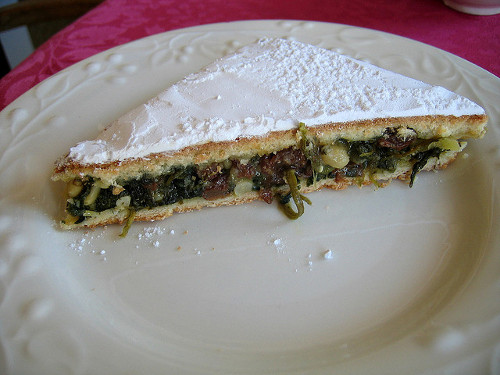
banlon1964 CC BY-NC-ND
The past ten years has seen the world go kale crazy, but the ancient Romans were putting leafy greens in everything since 200 B.C. That’s when Swiss chard proliferated throughout the Mediterranean region and made its way into countless traditional dishes. It seems the Nicoise could never get enough of the vegetable, adding it to gnocchi, pâtes, breads and soups throughout the centuries.
One of the most iconic chard dishes is—surprisingly—a dessert. Made from some of the region’s most prized ingredients, the tourte de blettes is like a representative of the Mediterranean larder. The filling features not only chard and sugar, but pastis, pine nuts, raisins, and grated parmesan, while the crust swaps butter for olive oil. Once baked, this double-crusted tourte is showered with a thick layer of powdered sugar so that there will be no mistaking it for anything other than a sweet treat.
Cremet d’Anjou – The Loire Valley
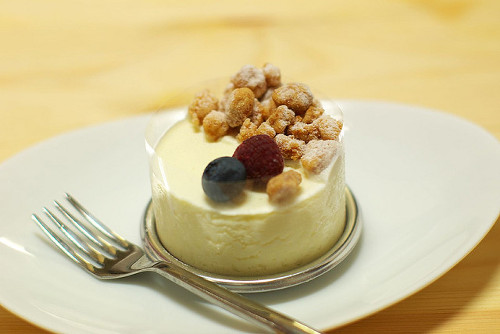
masa CC BY-NC
In 1921 Curnonsky, the famed food critic and “Prince of Gastronomy”, wrote: “The Angevin Crêmet is a feast of the gods!” Like everyone else in the Loire Valley, he’d fallen for the delicate mousse made famous in the 1700s by Marie Reneaúme, a home cook turned grocery owner. Madame Renéaume produced large quantities of the airy dessert and distributed it to the wider population through wholesale orders with restaurants and pushcart owners.
No matter how popular the cremets became, their delicate nature made—and still makes—them difficult to transport. “I know nothing that can be brought parallel with the Crêmet d’Anjou…[it] cannot be transported; you have to eat them on the spot,” Curnonsky said. Though this statement is true, it’s well worth the trouble to visit the Loire just to sample a spoonful of this feather-light concoction. Made from fresh cheese folded into whipped egg whites and cream, the crêmet truly tastes like a spoonful of cloud.
Andrea Duty is a pastry chef and freelance writer currently working on a book about regional French desserts. You can read about her sugar-fueled travels at www.thisnewview.com.
Main photo by Claude Despoisse/Getty